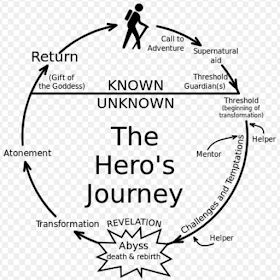Consider the development of basketball players and teams. Very often the most successful have humble enough origins. We hear the stories of Bill Russell or Michael Jordan and realize that the narrative didn't proceed with unadulterated success. They were not Botticelli products.
Botticelli's "Birth of Venus."
Which forces the question, what drives success, figuratively and literally? Brett Ledbetter has advanced the conversation with What Drives Winning.
The book is far more than this graphic...
The rags to riches story of team development has elements of "The Hero's Journey" within.
But the alchemy of success demands a lot of elements - leadership, followership, community, and intangibles including health, preparation, money, and luck. You need to get a few bounces along the way.
We hear a lot about bootstrapping, but sometimes you have no boots. Having a mentor or a champion along the way can help you immeasurably because they may know someone who can and will open a door for you...in basketball or elsewhere.
But I digress. What absolutes would I want in my Panglossian program?
Commitment. I want to be surrounded by people who want to succeed as badly as I do. But commitment seldom thrives in isolation. Commitment implies meaning and purpose. I regularly remind people that passion derives from the Latin "passionem" or suffering. Passionate people willingly suffer in pursuit of excellence.
Persistence. Talent is necessary but not sufficient.
Tempo. We have to prepare and practice at an accelerated pace. Most of the time we won't get the 10,000 hours, so we must make up for lost time. Practicing at a high tempo requires unusual concentration for young people.
Culture of success. Maintaining a culture of success requires a "why" factor.
Simon Sinek's "Golden Circle" explains internal drive...and it's relationship to brain structure and function. The neocortex (our newest brain) suffers slavery to our oldest, emotional, core limbic brain.
Teaching excellence. That's obvious but implies exceptional competence, communication, simplicity, AND inspiration. Usually, that mandates unusual curiosity on both the instructors and the students.
We cannot force our students to 'believe' in themselves, embrace our program, or care about basketball. But when we model a process leading to 'discovery arcs', then we create the nourishment that grows excellence. Some will eat.



